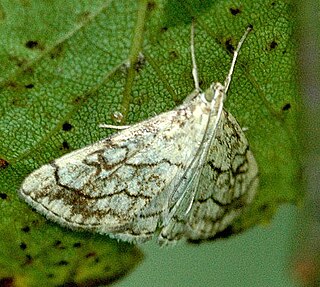
The Crambidae are the grass moth family of lepidopterans. They are variable in appearance, the nominal subfamily Crambinae taking up closely folded postures on grass stems where they are inconspicuous, while other subfamilies include brightly coloured and patterned insects which rest in wing-spread attitudes.

The Pyralidae, commonly called pyralid moths, snout moths or grass moths, are a family of Lepidoptera in the ditrysian superfamily Pyraloidea. In many classifications, the grass moths (Crambidae) are included in the Pyralidae as a subfamily, making the combined group one of the largest families in the Lepidoptera. The latest review by Eugene G. Munroe and Maria Alma Solis retain the Crambidae as a full family of Pyraloidea.

Evergestis pallidata is a species of moth of the family Crambidae described by Johann Siegfried Hufnagel in 1811. It is found in Europe, across the Palearctic and in North America.
Arequipa is a genus of moths of the family Crambidae. It contains only one species, Arequipa turbatella, which is found in North America, where it has been recorded from Alabama, Illinois, Maine, Maryland, North Carolina, Ohio, Ontario, Pennsylvania, Quebec and West Virginia.

Donacaula is a genus of moths of the family Crambidae. The genus was erected by Edward Meyrick in 1890.
Neocataclysta is a genus of moths of the family Crambidae. It contains only one species, Neocataclysta magnificalis, the scrollwork pyralid moth, which is found in North America, where it has been recorded from Florida, Georgia, Maine, Massachusetts, Mississippi, New Jersey, New York, North Carolina, Nova Scotia, Ohio, Ontario and South Carolina.
Paracorsia is a monotypic moth genus of the family Crambidae described by H. Marion in 1959. It contains only one species, Paracorsia repandalis, described by Michael Denis and Ignaz Schiffermüller in 1775. It is found in most of Europe, except Ireland, Fennoscandia and the Baltic region. It has also been recorded from central Asia, including Iran and Kyrgyzstan and North America where it has been recorded in southern Ontario and northern Indiana.

Sclerocona is a genus of moths of the family Crambidae which contains only one species, Sclerocona acutella. It was first described by the Prussian biologist Eduard Friedrich Eversmann in 1842.

Elophila obliteralis, the waterlily leafcutter moth, is a moth of the family Crambidae. It was described by Francis Walker in 1859. It is native to eastern North America. It is an introduced species in Hawaii and South Africa.

Agriphila deliella is a species of moth of the family Crambidae. It is found in most of Europe and North Africa and from Anatolia to Afghanistan.

Glaphyriinae is a subfamily of the lepidopteran family Crambidae. It was described by William Trowbridge Merrifield Forbes in 1923. The subfamily currently comprises 509 species in 75 genera.

Scopariinae is a subfamily of the lepidopteran family Crambidae. The subfamily was described by Achille Guenée in 1854.

Argyria rufisignella, the mother-of-pearl moth, is a moth in the family Crambidae. It was described by Zeller in 1872. It is found in North America, where it has been recorded from the eastern United States and in the south to Arizona.

Parapediasia decorellus, the graceful grass-veneer, is a moth in the family Crambidae. It was described by Zincken in 1821. It is found in North America, where it has been recorded from Alabama, Arkansas, Florida, Georgia, Illinois, Kansas, Maine, Maryland, Massachusetts, Missouri, New Hampshire, New Jersey, New Mexico, North Carolina, Ohio, Oklahoma, South Carolina, Tennessee and Texas.
Anania tennesseensis is a moth in the family Crambidae. It was described by Yang in 2012. It is found in North America, where it has been recorded from Tennessee.
Cangetta micralis is a moth in the family Crambidae. It is found in South America, the Caribbean and in southern Florida.
Ecpyrrhorrhoe puralis is a moth in the family Crambidae. It was described by South in 1901. It is found in China (Hubei). It is an introduced species in the eastern United States, where it has been recorded from Alabama, Georgia, Kentucky, Maryland, Mississippi, North Carolina, Pennsylvania, South Carolina, Tennessee and West Virginia.
Microthyris lelex is a moth in the family Crambidae. It was described by Pieter Cramer in 1777. It is widespread in the Caribbean, Central America and northern South America. Records include Suriname, Puerto Rico and Jamaica. It has recently been recorded from southern Florida.
Penestola bufalis, the black penestola moth, is a moth in the family Crambidae. It was described by Achille Guenée in 1854. It is found in the US states of Texas and Florida, as well as on the Antilles. It is an accidentally introduced species on the Galápagos Islands. The habitat consists of coastal mangrove swamps and shorelines.
Phostria oajacalis is a moth in the family Crambidae. It was described by Francis Walker in 1866. It is found in Nicaragua, Guatemala, Costa Rica., Mexico and the southern United States.










